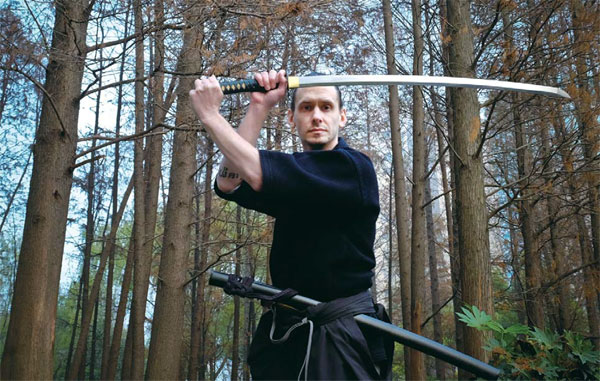The way of the ninja, the way it's meant to be
Updated: 2016-01-08 07:55
By Alywin Chew in Shanghai(China Daily Europe)
|
|||||||||||
A Frenchman is carving a niche for himself in Shanghai with his ninjutsu lessons and offering everyone a way to achieve holistic fitness
People often associate ninjutsu with the archetypal ninja, often depicted in popular culture as a stealthy assassin who lurks in the shadows with a sword on his back. But attend just one lesson in this ancient Japanese martial art and it will soon be clear that many things found on the Internet or seen in popular culture are nothing more than misconstrued facts.
"Ninja gear? You mean like a black hood and a sword on the back?" says David Saignes. "My friend, this is not Hollywood!"
|
NINJUTSU instructor David Saignes has been teaching the martial art in Shanghai for about six years. Alywin Chew / China Daily |
A ninjutsu instructor in Shanghai, Saignes holds the rank of fourth dan and conducts weekly classes at the dojo (training ground) on the second floor of the Xuhui Swimming Complex. The 33-year-old first arrived in the city in 2009 when he set up a landscaping design business. Surprised that there wasn't a dojo in Shanghai at that time, Saignes trained by himself in parks. However, he soon discovered that winter in Shanghai can be particularly unforgiving, which made practicing outdoors really uncomfortable, and decided to find a proper space to practice.
In 2010, Saignes decided to set up Bujinkan Tako Dojo, the first in China at that time, and started offering classes in ninjutsu and budo taijutsu, which refers to samurai combat techniques.
Although the Frenchman - who has 13 years of experience in the martial art - trains his students in the handling of weapons like wooden swords and spears, you won't find them donning hoods, throwing shurikens, disappearing in a cloud of smoke and doing the sort of things ninjas are often depicted doing in popular fiction.
"The sort of ninjas we often see today are legends from kabuki, or popular theater. Actually, the word 'ninja' has been around since the 19th century. In Japan, there used to be these guys dressed in black who would change the landscapes at puppet shows and people used to call these workers kuroko, which means 'black person', before calling them ninjas. Somehow that term was used to described people who were involved in covert military activities," says Saignes.
Historians discovered that ninjas only did so for the purpose of camouflage, usually to blend into the darkness of night when covert missions were carried out.
Ninjutsu, in reality, is one of the martial arts that fall under the Bujinkan, an international organization based in Japan. There are nine schools of combat methods under the Bujinkan, three of which fall under ninjutsu, while the other six are categorized as budo taijutsu.
"Ninjutsu refers to specialized combat techniques. Think of a SWAT team in the police force," says Saignes.
Compared to its modern counterparts such as karate or judo, both of which boast millions of practitioners worldwide, ninjutsu would probably be considered a very niche discipline. According to Saignes, there are just over 400,000 Bujinkan members around the world.
Students begin warming up for class by performing a series of tumbles on the mat. They then perform a bow and say "shikin haramitsu daikomyo", which according to Saignes means "to seek a bright future of enlightenment by loving, being true and persevering with dedication".
Saignes then guides them through a series of manoeuvres in which they learn how to evade oncoming attacks before retaliating with a swift counter. Weapons training revolves around the same concept and one particular technique involves parrying with a sword before moving the blade along the assailant's spear and slicing his guts open.
In this modern age, there is of course little need to be proficient in handling a sword, but it is nevertheless this aspect of ninjutsu, along with its mysterious nature, that proves alluring to many people.
"It's all about observing people, seeing how exposed and vulnerable they are," says Shelan Alexandre Daune, a 16-year-old student who is of French and Chinese parentage. "I love the biomechanics involved in this martial art."
For Gu Jie, one of the few locals who had signed up, it is learning self-defence techniques from a mysterious brand of martial arts that attracted him.
"My friends recommended that I pick up something to lose weight," he says. "I really like what I'm learning although some of the moves are a little hard to execute because I'm a little rotund. Besides, I also get to meet international peers."
"Ninjutsu requires us to control our alimentation, such as no alcohol, no smoking and no fast food. The dojo is like a laboratory where you practice but outside of it the training continues," says Saignes.
He also notes that ninjutsu is not a sport, but the truest form of a martial art - traditionally, martial arts practitioners are required to use weapons. Also, unlike karate, judo or taekwondo, there are no ninjutsu competitions.
Saignes has since been to Japan countless times over the years and has even met 84-year-old Grandmaster Masaaki Hatsumi on several occasions. He is planning to return to Noda in Japan's Chiba prefecture next year to undergo a test to receive his fifth dan.
alywin@chinadaily.com.cn
(China Daily European Weekly 01/08/2016 page15)
Today's Top News
Going mobile
Wealth of options for China's super-rich
Man with knife shot dead outside Paris police station
Trading halted after shares fall 7% in opening minutes
China voices its 'resolute opposition' to DPRK test
Design exhibition to attract Chinese art works
Germans shaken by mass attacks on women
Concerns grow over Saudi-Iranian rising tensions
Hot Topics
Lunar probe , China growth forecasts, Emission rules get tougher, China seen through 'colored lens', International board,
Editor's Picks

|

|

|

|

|

|







